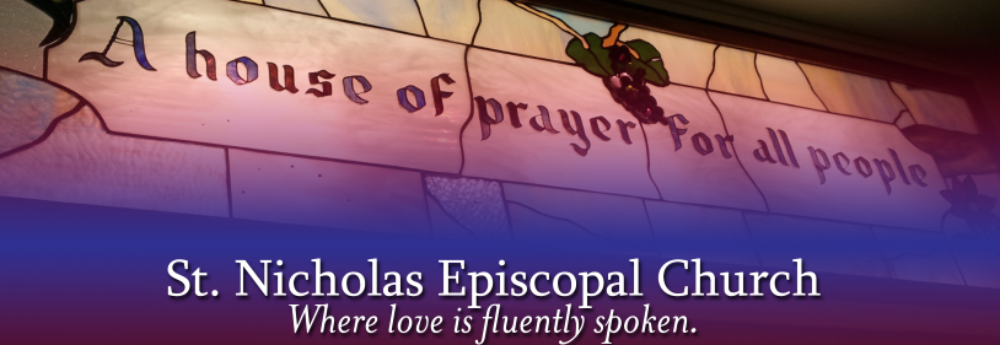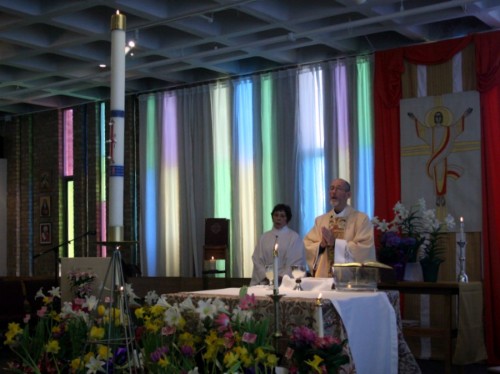The late Rev. Paul Brouillette presided at Easter Sunday 2011, in the semidarkness before all the lights were turned on. Father Paul loved chanting the Exultet. — Photo credit David Gibbs.
Tonight, the long Easter Vigil begins in darkness, and ends in light with joyful alleluias. There are a lot of readings, as the Creation story is retold and the Salvation is recounted. Each must have a musical response, and one or two have special choral responses. It is quite a long service – beginning at 8pm and ending at around 10:30pm or so, it runs the gamut from sorrow to overwhelming joy. Again this year, we are happy to have Alex with us again to act as trumpeter during the Gloria, also for a special choral piece called “Sound The Trumpet,” and during another traditional piece to end the service. In a new tradition beginning this year, the bell-ringing at the Easter Acclamation and during the following Gloria will be a little more glorious thanks to our parishioners who came from St Bede’s!
It will be a night of light bravely pushing back the darkness, both in the world and in our hearts. We will be moved to shout “Alleluia! He is Risen! He is Risen indeed,” and mean it.
A great deal of preparation goes into celebrating Easter at St Nicholas, as there are two “big” services back-to-back (after several other services each night of the Triduum, the three culminating days of Holy Week). Indeed, for each service this week, the worship space is rearranged to set the proper mood for each service; a handwashing station for Maundy Thursday, a simple wooden cross for veneration on Good Friday, and tonight a vast array of flowers and all the candleabra we’ve got will be arranged around the altar).
Many people have worked hard in the planning and preparation for Holy Week, and tonight’s Easter Vigil is really “the big one” in our hearts. Tomorrow’s triumphant and joyful Easter Sunday will have lots of wonderful music and fun for the young and young at heart (yes, the rumors are true, the Easter Bunny shall appear after church, and there will be many eggs to hunt).
But tonight is the only time of the year that the New Fire is kindled, and as the weather is likely to be reasonable, it will be done outdoors, at the Holy Innocents altar that stands out in front of the church. Plan to arrive early and dress warmly if you wish to watch outdoors, but the liturgy will be watched from inside by many (and there is a covered area across from the altar also).
Tonight, flames will be kindled from some of the dried palm leaves from Palm Sunday, and the big Paschal Candle will be lighted (not without some difficulty). Father Manny will push nails into it with incense – more symbolism of Christ’s crucifixion and burial in the tomb. And then the altar party will process slowly into the church, where the waiting congregation and choir will stand ready with hand candles.
As Father Manny enters the sanctuary, he will intone:
“The light of Christ!”
And the assembled will respond,
“Thanks be to God!”
He will repeat this twice more, and the acolytes will begin lighting everyone’s hand candles, so that the light spreads slowly into the church as we move to our seats.
The Exultet will be chanted in the semi-darkness, by several cantors and Father Manny:
Rejoice now, heavenly hosts and choirs of angels, and let your trumpets shout Salvation, for the victory of our mighty King. Rejoice and sing now, all the round earth, bright with a glorious splendor, for darkness has been vanquished by our eternal King. Rejoice and be glad now, Mother Church, and let your holy courts, in radiant light, resound with the praises of your people. All you who stand near this marvelous and holy flame, pray with me to God the Almighty for the grace to sing the worthy praise of this great light; through Jesus Christ his Son our Lord, who lives and reigns with him, in the unity of the Holy Spirit, one God for ever and ever.
You may have heard of the phrase “C and E Christian,” which refers to the attendance of church services only at Christmas and Easter. Well, if you only attend church sporadically, or are looking for a faith community, this is the night to attend. This night is a good night for beginning to walk the path of faith in community, a good night to follow the call to serve others.
Of course, Christmas Eve is hugely important at St Nicholas, as our patron saint the good Bishop of Myra has now morphed into the secular Santa Claus (and is beloved by children all over the world). And Easter Sunday is certainly a very big day at St Nicholas, when families bring children in their brand new Easter outfits (sometimes with baskets ready for the egg hunt after the service) and there’s still a lot of special music and color and beautiful liturgy, traditional in the Episcopal church but familiar to many.
But tonight is the night that defines Christianity for us: the Light comes into the world, and Salvation is ours for the asking.
For as the Exultet continues:
This is the night, when you brought our fathers and mothers, the children of Israel, out of bondage in Egypt, and led them through the Red Sea on dry land.
This is the night, when all who believe in Christ are delivered from the gloom of sin, and are restored to grace and holiness of life.
This is the night, when Christ broke the bonds of death and hell, and rose victorious from the grave.
How wonderful and beyond our knowing, O God, is your mercy and loving-kindness to us, that to redeem a slave, you gave a Son.
How holy is this night, when wickedness is put to flight, and sin is washed away. It restores innocence to the fallen, and joy to those who mourn. It casts out pride and hatred, and brings peace and concord.
How blessed is this night, when earth and heaven are joine danll are reconciled to God.
Holy Father, accept our evening sacrifice, the offering of this candle in your honor. May it shine continually to drive away all darkness.
May Christ, the Morning Star who knows no setting, find it ever burning — He who gives this light to all creation, and who lives and reigns for ever and ever.
And we all respond, Amen!
The banner image for Holy Saturday was taken at dawn from the summit of Haleakala, Maui. Photo credit Ginny Gibbs



